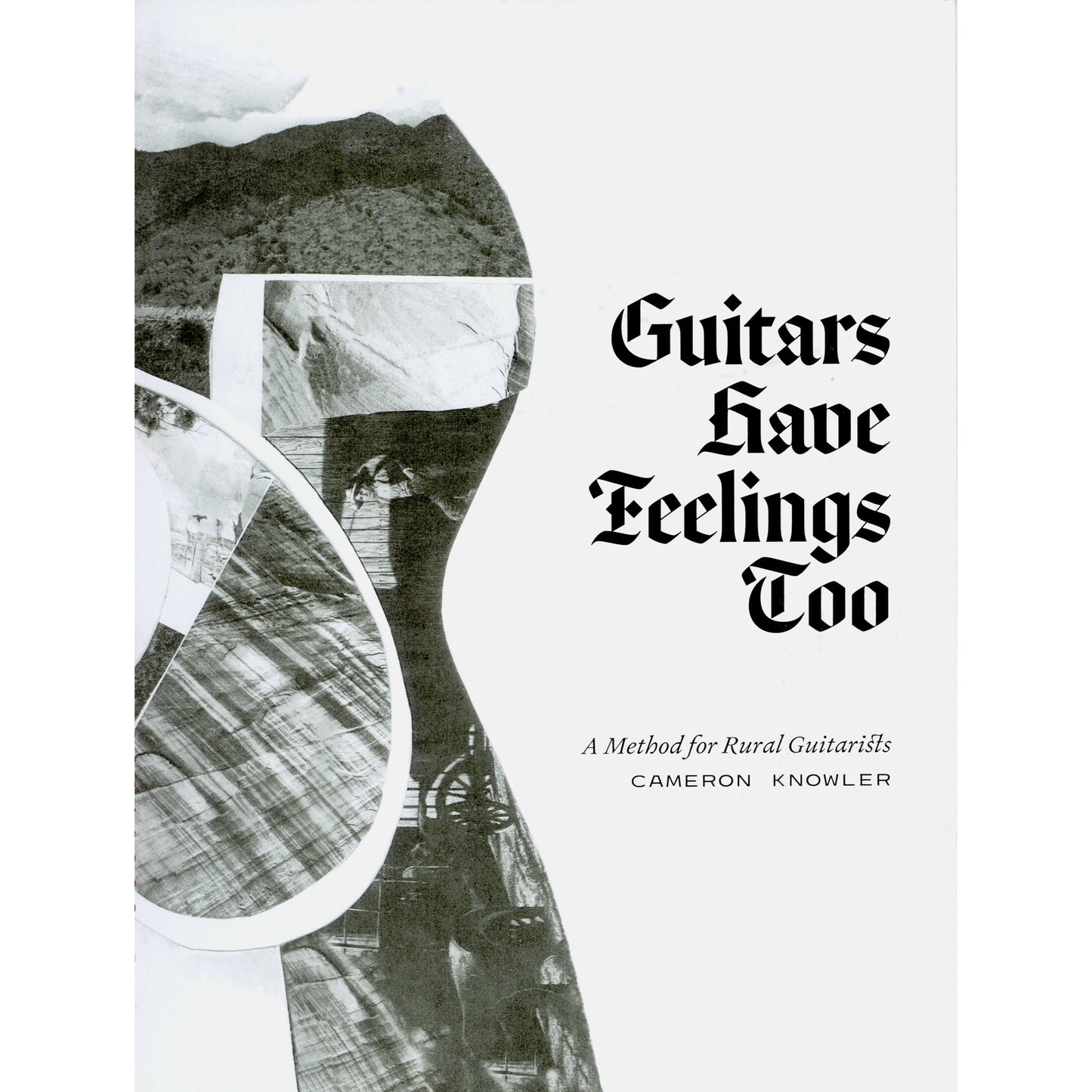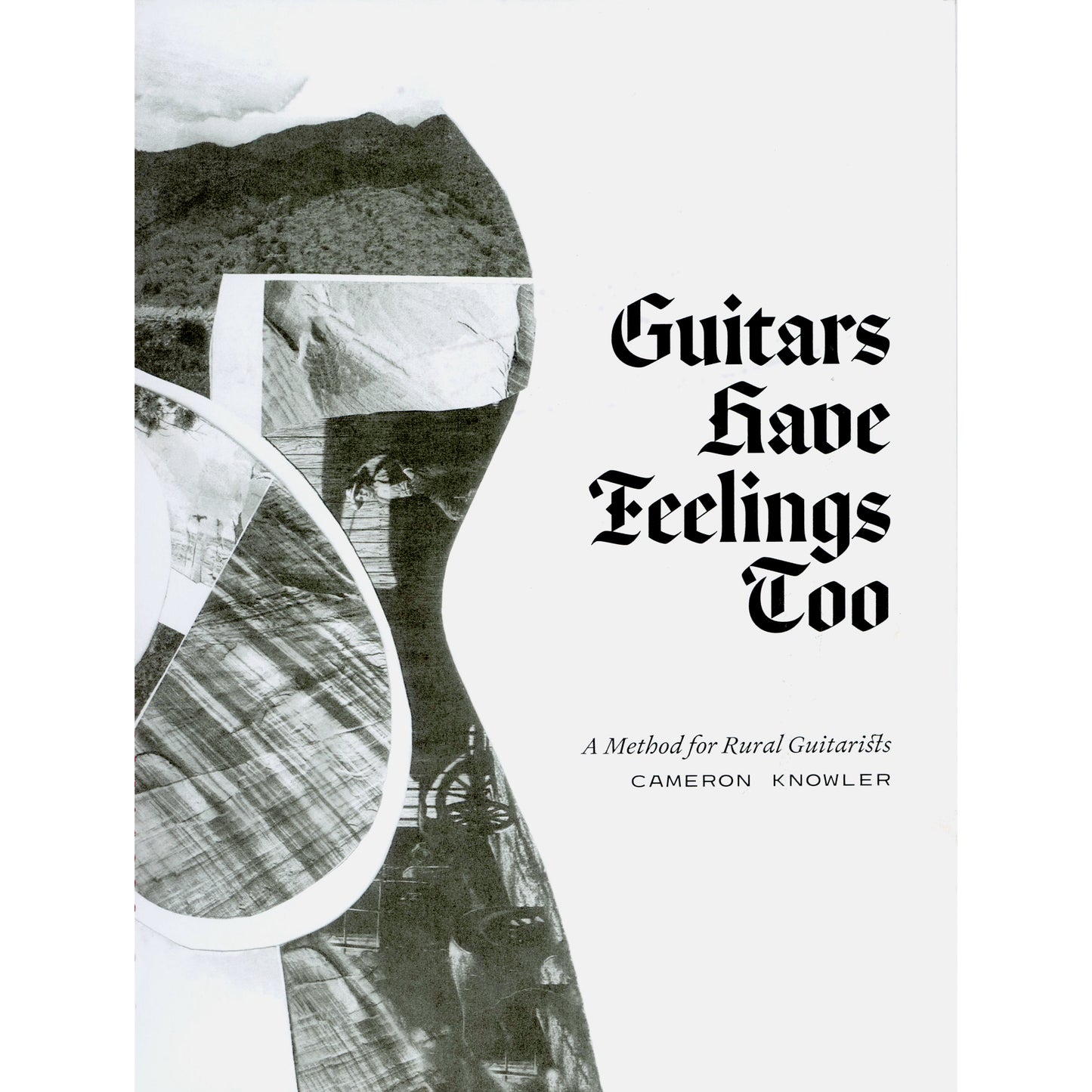-
 Guitars Have Feelings Too was written to improve upon the guitar book as a method of teaching, while developing a new perspective on the topic of flatpicking guitar. Analyzing the stylings of historically progressive backup guitar players (Jim Baxter, Norman Blake, Maybelle Carter, and Riley Puckett), the reader is led through the bedrock tenets of American rhythm guitar; one that is inherently progressive, Knowler argues. This conversation touches on technique, theory, and how to better listen to the information provided by the fiddle. Applying these interrelated points to the subject of melodic guitar, the last quarter of the book introduces a largely unknown guitarist who conveniently exists as a crossover between old-time and bluegrass music, while setting in motion various points made throughout the narrative. It is with this information that the reader is encouraged to reevaluate flatpicking guitar as a continuation of the dance traditions which later developed into bluegrass music, as opposed to a genre of purely virtuosic instrumental music. The format of this method book includes longer examples in the back, neatly labeled in an appendix, with shorter examples woven into the manuscript to aid a focused learning experience.
Guitars Have Feelings Too was written to improve upon the guitar book as a method of teaching, while developing a new perspective on the topic of flatpicking guitar. Analyzing the stylings of historically progressive backup guitar players (Jim Baxter, Norman Blake, Maybelle Carter, and Riley Puckett), the reader is led through the bedrock tenets of American rhythm guitar; one that is inherently progressive, Knowler argues. This conversation touches on technique, theory, and how to better listen to the information provided by the fiddle. Applying these interrelated points to the subject of melodic guitar, the last quarter of the book introduces a largely unknown guitarist who conveniently exists as a crossover between old-time and bluegrass music, while setting in motion various points made throughout the narrative. It is with this information that the reader is encouraged to reevaluate flatpicking guitar as a continuation of the dance traditions which later developed into bluegrass music, as opposed to a genre of purely virtuosic instrumental music. The format of this method book includes longer examples in the back, neatly labeled in an appendix, with shorter examples woven into the manuscript to aid a focused learning experience.
The exact appearance of this item may vary.
More Details -

1
/
of
2
More Details
More Details
Preface
Introduction
- Notation Notes
- Resources
- The Nature of Backup Guitar
- Knowing Your Role
- The Feel
- Play
- Holding the Pick
Chapter I - Mono Bass Pattern
- Rhythmic Fundamentals
- Basic Chord Shapes
Chapter II - Introducing a Tune
- Building a Road Map
Chapter III - Mommy, Where do Notes Come From
- Diatonicism (A Crash Course)
- Building Triads
- Chordal Function
- Back to the Tune
- Building Ideas
- Suggested Practice
Chapter IV - Walking Patterns and Bass Runs
- Phrase Endings
- Listening Practice
Chapter V - Chord Voices
- Application of Chordal Theory
- Suggested Practice
- Reflecting on our Conclusions
- Conclusion
Chapter VI - Stylization
- Riley Puckett “Tuba Style” or “Georgia Clave”
- More Layers to Puckett
- Further Listening (Narmour and Smith)
- How Much is Too Much?
Chapter VII - Syncopation
- Responding to Ghosts
- Looking Forward
Chapter VIII - Flatpicking
- Flatpicking's First Practitioner
- Flop Eared Mule
- The Flatpick as a Medium
- Norman Blake
- Bringing in the Georgia Mail
- Further Practice
- Mother Maybelle Carter
Appendix - Tablature, Sources
Guitars Have Feelings Too - A Method for Rural Guitarists
Guitars Have Feelings Too - A Method for Rural Guitarists
New
SKU: 823-1
Regular price
$60 USD
Regular price
Sale price
$60.00 USD
Unit price
/
per
Shipping calculated at checkout.
Experience the Elderly Difference
Guitars Have Feelings Too was written to improve upon the guitar book as a method of teaching, while developing a new perspective on the topic of flatpicking guitar. Analyzing the stylings of historically progressive backup guitar players (Jim Baxter, Norman Blake, Maybelle Carter, and Riley Puckett), the reader is led through the bedrock tenets of American rhythm guitar; one that is inherently progressive, Knowler argues. This conversation touches on technique, theory, and how to better listen to the information provided by the fiddle. Applying these interrelated points to the subject of melodic guitar, the last quarter of the book introduces a largely unknown guitarist who conveniently exists as a crossover between old-time and bluegrass music, while setting in motion various points made throughout the narrative. It is with this information that the reader is encouraged to reevaluate flatpicking guitar as a continuation of the dance traditions which later developed into bluegrass music, as opposed to a genre of purely virtuosic instrumental music. The format of this method book includes longer examples in the back, neatly labeled in an appendix, with shorter examples woven into the manuscript to aid a focused learning experience.
More DetailsCouldn't load pickup availability
More Details
More Details
Preface
Introduction
- Notation Notes
- Resources
- The Nature of Backup Guitar
- Knowing Your Role
- The Feel
- Play
- Holding the Pick
Chapter I - Mono Bass Pattern
- Rhythmic Fundamentals
- Basic Chord Shapes
Chapter II - Introducing a Tune
- Building a Road Map
Chapter III - Mommy, Where do Notes Come From
- Diatonicism (A Crash Course)
- Building Triads
- Chordal Function
- Back to the Tune
- Building Ideas
- Suggested Practice
Chapter IV - Walking Patterns and Bass Runs
- Phrase Endings
- Listening Practice
Chapter V - Chord Voices
- Application of Chordal Theory
- Suggested Practice
- Reflecting on our Conclusions
- Conclusion
Chapter VI - Stylization
- Riley Puckett “Tuba Style” or “Georgia Clave”
- More Layers to Puckett
- Further Listening (Narmour and Smith)
- How Much is Too Much?
Chapter VII - Syncopation
- Responding to Ghosts
- Looking Forward
Chapter VIII - Flatpicking
- Flatpicking's First Practitioner
- Flop Eared Mule
- The Flatpick as a Medium
- Norman Blake
- Bringing in the Georgia Mail
- Further Practice
- Mother Maybelle Carter
Appendix - Tablature, Sources





